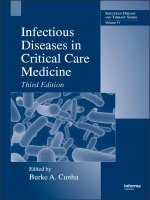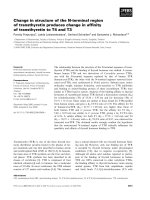Application of the International Classification of Diseases to Dentistry and Stomatology Third Edition potx
Bạn đang xem bản rút gọn của tài liệu. Xem và tải ngay bản đầy đủ của tài liệu tại đây (5.53 MB, 246 trang )
Application of the International
Classification of Diseases
to Dentistry and Stomatology
Third EditionApplication of
the International
Classification
of Diseases to
Dentistry and
Stomatology
Third Edition
World Health Organization
Geneva
1995
n
First edition 1973
Second edition 1978
Third edition 1994
WHO Library Cataloguing in Publication Data
Application of the International Classification of Diseases to dentistry and stomatology:
ICD-DA. — 3rd ed.
1.Mouth
diseases — classification
2.Mouth neoplasms — classification
3.Tooth diseases — classification
ISBN 92 4 154467 8 (NLM Classification: WU 15)
The World Health Organization welcomes requests for permission to reproduce or translate its
publications, in part or in full. Applications and enquiries should be addressed to the Office of
Publications, World Health Organization, Geneva, Switzerland, which will be glad to provide the
latest information on any changes made to the text, plans for new editions, and reprints and
translations already available.
© World Health Organization 1995
Publications of the World Health Organization enjoy copyright protection in accordance with the
provisions of Protocol 2 of the Universal Copyright Convention. All rights reserved.
The designations employed and the presentation of the material in this publication do not imply the
expression of any opinion whatsoever on the part of the Secretariat of the World Health
Organization concerning the legal status of any country, territory, city or area or of its authorities, or
concerning the delimitation of its frontiers or boundaries.
The mention of specific companies or of certain manufacturers' products does not imply that they
are endorsed or recommended by the World Health Organization in preference to others of a similar
nature that are not mentioned. Errors and omissions excepted, the names of proprietary products
are distinguished by initial capital letters.
Typeset in India
Printed in England
93/9818-Macmillan/Clays-8 500
Contents
Preface to the third edition v
Introduction 1
The International Classification of Diseases 2
ICD-DA 3
Recommended use of ICD-DA 6
ICD-DA tabular list 9
Extract from numerical index of morphology of neoplasms (ICD-O) 132
Annex 1. Histological typing of odontogenic tumours 144
Annex 2. Histological typing of salivary gland tumours 147
Index 149
iii
On the initiative of the International Dental Federation, a meeting of consul-
tants was convened by the World Health Organization in 1964 to consider the
classification of diseases of the buccal cavity in relation to the impending Eighth
(1965) Revision of the International Classification of Diseases (ICD). It was
recognized that a manual and guide should be compiled to assist in the
application of the ICD to dentistry and stomatology. Accordingly, a text was
drafted and tested in four countries, then revised and published for general use.
The first version of the Application of the International Classification of Diseases
to Dentistry and Stomatology (ICD-DA) was issued in English in 1969, followed
by publication in Spanish in 1970.
1
The first WHO edition was published in
English in
1973.
2
Publication of the Ninth Revision of ICD, which came into effect in Member
States in 1978, gave rise to the second edition of ICD-DA.
3
This third edition
has been prepared as a companion volume to ICD-10, the Tenth Revision of
ICD.
WHO gratefully acknowledges the work done by the many national institutes
and individual specialists who contributed to the preparation and revision
of ICD-DA. Special acknowledgements are due to Professor I.R.H. Kramer,
Emeritus Professor of Oral Pathology, University of London, London,
England, and Professor J.J. Pindborg, Dental School, University of Copen-
hagen, Copenhagen, Denmark, who have assumed the major responsibility for
the preparation of all three editions of ICD-DA.
1
Application of the International Classification of
Diseases
to Dentistry and Stomatology
(ICD-DA).
Copenhagen, Dental Department, University Hospital, 1969.
Clasificacibn internacional de enfermedades, aplicada a odontologia y estomatologia.
Washington, DC, Pan American Health Organization, 1970 (PAHO Scientific Publi-
cation No. 206).
2
Application of the International Classification of
Diseases
to Dentistry and Stomatology
(ICD-DA).
Geneva, World Health Organization, 1973.
3
Application of the International Classification of
Diseases
to Dentistry and Stomatology
(I
CD-DA),
2nd ed. Geneva, World Health Organization, 1978.
v
When any substantial volume of data has to be recorded, a coherent system of
classifying and coding the data is essential, particularly where electronic or
mechanical means of retrieval or analysis are to be used.
The Application of the International Classification of Diseases to Dentistry and
Stomatology (ICD-DA) is intended to provide a practical and convenient basis
for the classification and coding of data by all those working in the field of oral
and dental disorders. It is derived directly from the Tenth Revision of the
International Classification of Diseases (ICD-10),
1
and is concerned with all
diseases and conditions that occur in, have manifestations in, or are associated
with the oral cavity and adjacent structures.
For the purposes of ICD-DA, most of the classifications provided by ICD-10
have been subdivided and expanded; however, data from ICD-DA can be
reassembled into ICD categories by simple addition. It is strongly recommended
that ICD-DA be used with ICD-10 available for reference; use of ICD-10 alone
is unsuitable for the following reasons:
• categories for the diseases and conditions of interest to oral health personnel
are insufficiently subdivided;
• the diseases and conditions are scattered throughout the large volume,
which makes its use in oral health facilities both awkward and time-
consuming.
The principal objectives of ICD-DA are thus:
• to focus the attention of oral health personnel on detailed diagnosis for each
patient, using a comprehensive and consistent classification of oral diseases
and oral manifestations of other diseases;
1
International Statistical Classification of
Diseases
and Related Health Problems. Tenth
revision. Geneva, World Health Organization.
Volume 1. Tabular list. 1992
Volume 2. Instruction manual. 1993
Volume 3. Alphabetical index. 1994
1
ICD-DA
• to provide a standard recording system for all oral diseases and conditions;
• by means of the recording system, to make possible the collection of data
that will allow the prevalence of oral diseases and conditions to be compared
at an international level.
In addition to facilitating international collaboration and exchange of informa-
tion, it is hoped that the ICD-DA system will contribute substantially to the
collection of epidemiological data on the rarer oral diseases, for which purpose
the survey method is impracticable.
ICD-DA is of value to a wide variety of
users,
from governments collecting basic
data to individual researchers, practitioners, and lecturers who require a
convenient method for indexing their records and teaching material. It can be
used in a contracted form, consisting of a relatively small number of broad
headings, or in an expanded form that allows detailed analysis in areas of special
interest.
The International Classification of Diseases
Readers and users of ICD-DA are referred to ICD-10 for a detailed treatment of
the general principles, background, and description of the ICD classification.
The following description includes only those features of immediate relevance to
the use of ICD-DA.
The ICD is a systematic classification of diseases, subject to agreement by
governments. It is widely used for national mortality and morbidity statistics,
and is revised periodically. The Tenth Revision — ICD-10 — came into effect
from January 1993; it consists of three separate volumes. Volume 1 includes an
explanatory text and a tabular, alphanumeric presentation of the classification.
Volume 2 is the instruction manual, which provides coding guidance and
general advice on the use of the classification. Volume 3 is a detailed alphabet-
ical index of all diseases and conditions covered by the classification. The
taxonomic philosophy of the ICD is necessarily somewhat eclectic: because of
differing national views on disease classification and terminology, no strictly
systematic classification is entirely practicable.
Volume 1 of ICD-10 is arranged in 21 main sections, or chapters, and this
arrangement has been followed for ICD-DA. It also contains a coded nomen-
clature of the morphology of neoplasms, an extract of which is included in ICD-
DA. Not every condition is allotted an individual rubric or number, but there
is a category to which every condition can be referred; this has been achieved
by the method of selective grouping. The principles for determining which
2
INTRODUCTION
conditions should be assigned to discrete categories are based on frequency,
importance, and clarity of characterization of the conditions.
In the alphanumeric system of codes that has been adopted, the detailed
categories of the classification are designated by a letter and two numbers. In
many instances, the first two characters of the three-character code designate
important or summary groups that are significant. The third character divides
each summary group into categories that represent either specific disease entities
or a classification of diseases or conditions according to some significant axis,
such as anatomical site. The three-character categories have not been numbered
consecutively: codes have been omitted from the order sequence to preserve the
summary character of the first two characters wherever it is meaningful. No
additional three-character categories may be introduced into the classification,
except when the list is revised by international agreement. Use of a fourth
character in the classification allows for more comprehensive studies of the
causes of illness and disability.
Efforts have been made to show most of the diagnostic terms given in standard
or official nomenclatures, as well as terms commonly used in different countries;
these are collectively referred to as "inclusion terms". Where there is any
significant risk of a condition being wrongly classified, cross-reference to
relevant categories is achieved by means of "exclusion terms". The last two codes
at the four-character level (.8 and .9) very often carry the connotation "other"
and "unspecified" respectively. The abbreviation "NOS" is attached to many
inclusion terms; it stands for "not otherwise specified" and is virtually the
equivalent of "unspecified" and "unqualified".
Overall, the arrangement of ICD-10 differs little from that of ICD-9, although
there is much additional detail. Certain innovations of ICD-10 are detailed on
pages 13-15 of Volume 1.
ICD-DA
Like ICD-10, ICD-DA has a tabular section and a comprehensive alphabetical
index. Liberal use has been made of inclusion and exclusion terms in the tabular
section to afford users as much assistance as possible in finding the correct
category for any condition diagnosed.
Coding system of ICD-DA
Each main code heading in the ICD-DA is an ICD code at the three-character
level. Titles for each of these codes and for code groups and main sections
remain exactly the same as those given in ICD-10.
3
ICD-DA
However, much of ICD-DA is based on five-character codes related to ICD
three- and four-character codes in the following way: the first three or four
characters of any ICD-DA code are those of ICD-10; where a fifth character is
used it is exclusive to ICD-DA. Where a five-character ICD-DA code relates to
a three-character ICD-10 category that has no fourth character subdivisions, a
dummy character "X" is used as the fourth character in ICD-DA. In a few
instances, a fourth character exists in ICD-10 but is irrelevant to ICD-DA; in
these cases it is replaced by the dummy fourth character "V". The fifth character
identifies ICD-DA subdivisions of the ICD category; where the ICD-DA
identifies a complete ICD category without further subdivisions, the dummy
"X"
is used as the fifth character. The coding system may be summarized as
follows:
Character
1
2
3
4
5
A-Z
0-9
0-9
0-9
X
V
0-9
X
ICD-10 three-character category
ICD-10 fourth character
ICD-10 fourth character does not exist
ICD-10 fourth character exists but is not used in ICD-DA
ICD-DA fifth character
ICD-DA fifth character does not exist
Use of the V code enables summaries to be made of oral manifestations of
general disease categories. They would not be added to national returns to avoid
duplication. The term "oral manifestations" is used in the broadest sense,
referring both to conditions that may be observed on clinical inspection, e.g. oral
manifestations of zoster (B02.8X), and to conditions not readily observed, e.g.
oral manifestations of Albright's syndrome (Q78.1X) affecting the jaws.
Neoplasm section
The section on neoplasms, both malignant and benign, is primarily, and as far as
possible, classified according to topography. Similarly, every effort has been
made to make the malignant and benign classifications parallel and to dis-
tinguish between neoplasms and hyperplasias that are reactive or inflammatory.
4
INTRODUCTION
Extracts from the International Histological Classification of Tumours have
been included as annexes to ICD-DA. Those of special interest in the field of oral
health are concerned with odontogenic tumours
1
and salivary gland tumours
2
and appear in Annexes 1 and 2 respectively.
For morphological coding of neoplasms, which is not provided by the ICD-DA
proper, an extract of the relevant part of the morphology (M) code of the
ICD-O
3
is given on pages 132-143.
Recommended use of ICD-DA
ICD-DA may be used at national, regional, institutional, or individual practice
level. The recommended procedure is as follows:
1.
All diagnoses must be recorded at the appropriate level, i.e. as three-, four-,
or five-character codes.
Pretesting has shown that it is extremely rare to have more than 12
diagnoses for any one patient.
2.
The most effective way to introduce and maintain ICD-DA recording is
probably office coding of written or electronically recorded diagnoses,
rather than direct entry of ICD-DA numbers in clinical records at the time
of examination. One clerical assistant, familiar with ICD-DA, could code
each day's diagnoses for a number of examiners with a high level of
consistency. An example of a form suitable for ICD-DA recording and for
annual summary (mostly on the basis of number of cases per population)
for national and international use is shown on the next page. Those using
ICD-DA will probably find it most convenient to design their own forms,
make local arrangements for computer summaries, and keep WHO in
Geneva informed of annual results. In case of difficulty, the Oral Health
unit of WHO
4
may be able to assist in designing computer summary forms
tailored to the needs of a particular institution or country and in perform-
ing the annual summaries.
Cramer IRH, Pindborg JJ, Shear M. Histological typing of odontogenic tumours, 2nd ed.
Berlin, Springer-Verlag, 1992.
2
Seifert G. Histological typing of salivary gland tumours, 2nd ed. Berlin, Springer-Verlag,
1991.
3
International Classification of Diseases for Oncology, 2nd ed. Geneva, World Health
Organization, 1990.
^
Oral Health, World Health Organization, 1211 Geneva 27, Switzerland.
5
ICD-DA
Adaptation of existing record systems may be more appropriate for some
national systems than introduction of the type of form shown below, but
whatever provision is made for use of ICD-DA, allowance should be made
for further subdivision resulting from periodic revisions of the ICD and
ICD-DA.
3.
Until users are familiar with the classification, it is important to consult the
index, main headings, and inclusion/exclusion terms before recording a
diagnosis.
Example 1
In general, the term "oral mucosa" is applicable to the superficial tissues of
the tongue as well as to other soft tissue surfaces of the oral cavity. In many
cases,
however, there is a separate classification for a set of diseases or
conditions depending on whether they occur in the tongue or in other parts
of the oral mucosa. Thus K12.ll is geographic stomatitis of oral epi-
thelium, but K14.1 is geographic tongue. Scanning the index under
"geographic" should reveal this distinction, but even if the index were to
refer only to geographic stomatitis K
12.11,
the exclusion term would reveal
that geographic tongue is
K14.1.
AGE
YEARS
OPTIONAL CODES
OCCUPATION
ETHNIC GROUP
PATIENT TYPE
RELIGION
TYPE
OF
INSTITUTION | | |
EXAMINING STAFF | | 1
ICD-DA CODES
H I I I I I 9| I I I I I
2
I
I 1 1 I I
"I
I I I I I
3
I I I I I I
ii|_U_LLl
4
LL_LXLJ
5
l
i i I I I
'MINI
13
i i
7
i i i i I I is I I I I I I
8
I I I I I I "I I I I I I
6
M
= 0
SEX
F= 1
12
14
INTRODUCTION
Example 2
The user may rapidly memorize the more important three-character titles
such as K05 Gingivitis and periodontal diseases. In a case of, say, acute
necrotizing ulcerative gingivitis, consultation of K05.0, Acute gingivitis,
before the diagnosis is recorded would show—from the exclusion term—
that the correct code for the condition is A69.10.
4.
It is usual to reserve .8 and .9 in the first or second decimal place for "other"
and "unspecified" conditions. The classification "other" is used for condi-
tions that are specified, but not otherwise classified, e.g. B23.8X HIV
disease resulting in other specified conditions—oral manifestations. The
classification "unspecified" is used either for an omission in diagnosis, e.g.
C00.9,
Malignant neoplasm of lip, unspecified, where location on one or
other lip has been omitted at examination; or for inability to be specific, e.g.
K03.79,
Posteruptive colour change of dental hard tissues, unspecified.
5.
In coding a case in which the diagnosis is uncertain, the appropriate
category must be found to indicate the general nature or site of the lesion,
with an "unspecified" diagnosis.
For example, if it is not established whether a lesion is a radicular cyst
or an apical granuloma, the correct code is K04.9, Other and unspecified
diseases of the pulp and periapical tissues, because the exact nature
of the lesion cannot be specified. It would be incorrect to use two
codings—K04.80, Radicular cyst, apical and lateral, and K04.5, Apical
granuloma—to indicate the uncertainty.
Similarly, if a patient has mucosal lesions that might be due to erythema
multiforme, lichen planus, or mucous membrane pemphigoid, and the
diagnosis is not established with confidence, the correct coding would be
K
13.79,
Lesion of oral mucosa, unspecified; it would be wrong to code all
three conditions included in the list of possible diagnoses.
6. In cases where no diagnosis is established, the coding used should indicate
the nature, type, or location of the lesion as narrowly as possible. For
example, an undiagnosed condition of the lips would be coded K
13.09,
Disease of
lips,
unspecified; and a glossitis of undetermined type would be
coded K
14.09,
Glossitis, unspecified.
7.
Wherever provision is made for recording oral manifestations of a
general disease or condition, the results have no meaning in terms of
national statistics for that disease or condition. They do, however, provide
an estimate of the frequency of oral manifestations of the disease or
condition, a measure that is unlikely to be available consistently elsewhere.
7
ICD-DA
8. Synonyms are provided in parentheses where there is some controversy or
in deference to usage, but the title outside parentheses is preferred.
9, Besides multiple topographical involvement, there are times when it is
necessary to classify one disease or condition under more than one
category. A syndrome (see complete list in index) should be classified by the
specific code allotted to it, but certain aspects of the condition, e.g. oral
clefts occurring as part of a syndrome, may also need to be classified under
other codes.
10.
It is essential for the user of ICD-DA to develop a consistent diagnostic
system, and certain reference texts will be needed. The Oral Health unit of
WHO
1
is prepared to assist by recommending suitable current texts on
request.
11.
The user should keep in mind the importance of providing feedback to the
Oral Health unit of WHO on difficulties encountered in using the ICD-
DA, so that improvements can be made.
12.
In addition to its application to the collection of data for health sta-
tistics, ICD-DA is also being used by oral pathology departments in the
context of storage of literature reference cards and collections of
slides/transparencies for teaching purposes. Such materials are useful for
teaching oral diagnosis, oral medicine, oral pathology, and oral surgery.
Health, World Health Organization, 1211 Geneva 27, Switzerland.
8
Oral
ICD-DA tabular list
I. Certain infectious and parasitic diseases
II.
Neoplasms
III.
Diseases of the blood and blood-forming organs and certain dis-
orders involving the immune mechanism
IV. Endocrine, nutritional and metabolic diseases
V. Mental and behavioural disorders
VI.
Diseases of the nervous system
IX. Diseases of the circulatory system
X. Diseases of the respiratory system
XI.
Diseases of the digestive system
XII.
Diseases of the skin and subcutaneous tissue
XIII. Diseases of the musculoskeletal system and connective tissue
XIV. Diseases of the genitourinary system
XV. Pregnancy, childbirth and the puerperium
XVII. Congenital malformations, deformations and chromosomal abnor-
malities
XVIII. Symptoms, signs and abnormal clinical and laboratory findings, not
elsewhere classified
XIX. Injury, poisoning and certain other consequences of external causes
XX. External causes of morbidity and mortality
9
9
Certain infectious and parasitic
diseases
Tuberculosis
Tuberculosis of other organs
A18.0 Tuberculosis of bones and joints
A18.00 Jaws
Temporomandibular joint
A18.2 Tuberculous peripheral lymphadenopathy
A18.2X Facial and cervical region
A18.8 Tuberculosis of other specified organs
A18.8X Mouth
Tularaemia
A21.0 Ulceroglandular tularaemia
A21.0X Oral manifestations
A21.8 Other forms of tularaemia
A21.8X Oral manifestations
Anthrax
A22.8 Other forms of anthrax
A22.8X Oral manifestations
Certain zoonotic bacterial diseases
Brucellosis
A23.0 Brucellosis due to Brucella melitensis
A23.0X Oral manifestations
11
ICD-DA
Glanders and melioidosis
A24.3 Other melioidosis
A24.3X Oral manifestations
Other zoonotic bacterial diseases, not elsewhere
classified
A28.1 Cat-scratch disease
A28.10 Oral manifestations
A28.11 Cervical lymphadenopathy
Other bacterial diseases
Leprosy
A30.VX Oral manifestations
Infection due to other mycobacteria
A31.8 Other mycobacterial infections
A31.80 Oral lesions
due to
Mycobacterium intracellulare
A31.81 Oral lesions
due to
Mycobacterium chelonei
A31.88 Oral lesions
due to
other
and
unspecified
mycobacteria
Other tetanus
A35.XX Oral manifestations
Diphtheria
A36.VX Oral manifestations
Whooping cough
A37.VX Oral manifestations
Scarlet fever
Excludes: streptococcal gingivostomatitis (K05.00)
A38.XX Oral manifestations
Meningococcal infection
A39.VX Oral manifestations
12
CERTAIN INFECTIOUS AND PARASITIC DISEASES
Actinomycosis
A42.2 Cervicofacial actinomycosis
A42.2X Oral manifestations
Nocardiosis
A43.8 Other forms of nocardiosis
A43.8X Oral manifestations
Infections with a predominantly sexual mode of
transmission
Excludes: human immunodeficiency virus [HIV] disease (B20-B24)
Congenital syphilis
A50.0 Early congenital syphilis, symptomatic
A50.0X Oral mucous patches
A50.5 Other late congenital syphilis, symptomatic
A50.50 Circumoral furrows [Parrot's furrows]
A50.51 Hutchinson's incisors
A50.52 Mulberry molars
A50.58 Other specified oral manifestations
A50.59 Oral manifestation, unspecified
Early syphilis
A51.2 Primary syphilis of other sites
A51.2X Oral manifestations
A51.3 Secondary syphilis of skin and mucous membranes
A51.3X Oral manifestations
Late syphilis
A52.7 Other symptomatic late syphilis
A52.70 Gumma of oral tissues
Excludes:
palatal perforation due to syphilis (A52.71)
A52.71 Palatal perforation due to syphilis
A52.72 Syphilitic glossitis
A52.73 Syphilitic osteomyelitis of jaw
A52.78 Other specified oral manifestations
A52.79 Oral manifestation, unspecified
13
ICD-DA
Gonococcal infection
A54.4 Gonococcal infection of musculoskeletal system
A54.4X Gonococcal infection of temporomandibuiar joint
A54.8 Other gonococcal infections
A54.8X Gonococcal stomatitis
Chlamydial lymphogranuloma (venereum)
A55.XX Oral manifestations
Granuloma inguinale
A58.XX Oral manifestations
Other spirochaetal diseases
Nonvenereal syphilis
Includes: bejel
A65.XX Oral manifestations
Yaws
A66.4 Gummata and ulcers of yaws
A66.4X Oral manifestations
A66.6 Bone and joint lesions of yaws
A66.6X Oral manifestations
A66.7 Other manifestations of yaws
A66.7X Oral manifestations
Other spirochaetal infections
A69.0 Necrotizing ulcerative stomatitis
Cancrum oris
Fusospirochaetal gangrene
Noma
Stomatitis gangrenosa
A69.1 Other Vincent's infections
A69.10 Acute necrotizing ulcerative gingivitis
[fusospirochaetal gingivitis] [Vincent's gingivitis]
A69.11 Vincent's angina
14
CERTAIN INFECTIOUS AND PARASITIC DISEASES
Rickettsioses
Typhus fever
A75.VX Oral manifestations
Spotted fever [tick-borne rickettsioses]
A77.VX Oral manifestations
Arthropod-borne viral fevers and viral haemorrhagic
fevers
Other arthropod-borne viral fevers, not
elsewhere classified
A93.8 Other specified arthropod-borne viral fevers
A93.8X Vesicular stomatitis virus disease [Indiana fever]
Viral infections characterized by skin and mucous
membrane lesions
Herpesviral [herpes simplex] infections
Excludes: herpangina (B08.5X)
BOO.O Eczema herpeticum
BOO.OX Kaposi's varicelliform eruption, oral manifestations
B00.1 Herpesviral vesicular dermatitis
BOO.10 Herpes simplex facialis
BOO.11 Herpes simplex labialis
B00.2 Herpesviral gingivostomatitis and pharyngotonsillitis
B00.2X Herpesviral gingivostomatitis
B00.8 Other forms of herpesviral infection
B00.8X Herpesviral whitlow
Varicella [chickenpox]
B01.8 Varicella with other complications
B01.8X Oral manifestations
15
ICD-DA
Zoster [herpes zoster]
Includes: shingles
B02.2 Zoster with other nervous system involvement
B02.20 Postherpetic trigeminal neuralgia
B02.21 Postherpetic neuralgia, other cranial nerves
B02.8 Zoster with other complications
B02.8X Oral manifestations
Smallpox
1
Measles
Measles with other complications
B05.8X Oral manifestations
Koplik's spots
Rubella [German measles]
Rubella with other complications
B06.8X Oral manifestations
Viral warts
B07.X0 Oral verruca vulgaris
B07.X1 Oral condyloma acuminatum
B07.X2 Focal epithelial hyperplasia
B07.X8 Other specified oral manifestations
B07.X9 Oral manifestation, unspecified
Other viral infections characterized by skin and
mucous membrane lesions, not elsewhere
classified
B08.0 Other orthopoxvirus infections
B08.00 Oral manifestations of orf
B08.01 Oral manifestations of vaccinia
B08.08 Oral manifestations of other orthopoxviral
infections
*In 1980 the 33rd World Health Assembly declared that smallpox had been eradicated.
The classification is maintained for surveillance purposes.
16
B05.8
B06.8
CERTAIN INFECTIOUS
AND
PARASITIC DISEASES
B08.1 Molluscum contagiosum
B08.1X Oral manifestations
B08.3 Erythema infectiosum [fifth disease]
B08.3X Oral manifestations
B08.4 Enteroviral vesicular stomatitis with exanthem
Includes: hand, foot and mouth disease
B08.4X Enteroviral vesicular stomatitis
B08.5 Enteroviral vesicular pharyngitis
Herpangina
B08.8 Other specified viral infections characterized
by
skin
and
mucous membrane lesions
Includes: epizootic stomatitis
B08.8X Oral manifestations of foot-and-mouth disease
Excludes: oral manifestations
of
hand, foot
and
mouth
disease (B08.4X)
Human
immunodeficiency virus [HIV] disease
Human immunodeficiency virus [HIV] disease
resulting
in
infectious
and
parasitic diseases
Excludes: acute
HIV
infection syndrome (B23.0)
B20.0
HIV
disease resulting
in
mycobacterial infection
Includes:
HIV
disease resulting
in
tuberculosis
B20.0X Oral manifestations
B20.1
HIV
disease resulting
in
other bacterial infections
B20.1X Oral manifestations
B20.2
HIV
disease resulting
in
cytomegaloviral disease
B20.2X Oral manifestations
B20.3
HIV
disease resulting
in
other viral infections
B20.3X Oral manifestations
B20.4
HIV
disease resulting
in
candidiasis
B20.4X Oral manifestations
B20.5
HIV
disease resulting
in
other mycoses
B20.5X Oral manifestations
B20.7
HIV
disease resulting
in
multiple infections
B20.7X Oral manifestations
17









